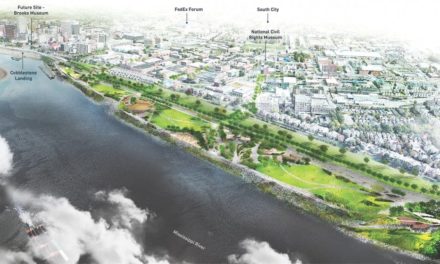We have been blogging for more than five years about the pivot point to be provided by the Memphis bicentennial and the opportunity to point the city toward the future with a clear sense of its priorities and purpose for its third century.
That’s why we are hoping that now that the big party at Tom Lee Park is over, the legacy of this bicentennial milestone is not simply that Memphis had the longest picnic table as certified by the Guinness Book of World Records.
A month ago, we wrote about our hope that the bicentennial would be as much about illumination as celebration, especially considering that much of the past 200 years has been no picnic for African Americans.
Acknowledging that reality, the 200th birthday of Memphis offered up the chance for a minority majority city to come together to imagine how to achieve a future known for opportunity, social and economic equity, and income equality.
Place and Talent
About four years ago, a question about Memphis’ third century, at a convening by the New Memphis Institute, was put to Joe Cortright, Portland economist, urban analyst, and the brain behind nationally respected City Observatory, and Carol Coletta, senior fellow with the Kresge Foundation’s American Cities Program, one of Planetizen’s top 100 Urban Thinkers, and highly sought after speaker across the U.S. about what makes cities successful.
Mr. Cortright said: “People who are committed to the future and what they do in their cities cannot be underestimated.” Ms. Coletta added that the objective at the time was to see the years leading up to the bicentennial as the “runway for Memphis’ third century” and to “start imagining what we can do in the next 10 years.”
The “biggest challenge,” according to Mr. Cortright, “is asking the right question.” He said: “When we think about the success of cities, it hinges on citizens and a citizenship. Even in a global economy, people who are committed to the future and what they do in their cities can’t be underestimated.
“It’s all about place and talent. Talented people are mobile so if you don’t have a great place, it is very hard to hang on to educated people in the community. This is important because a better educated city is a more successful city. A person with just a high school diploma earns more in a city with higher educational attainment because there is more economic opportunity.”
It’s why, Ms. Coletta said those four years ago, downtown needs more vibrancy and that the strengths in North and South Memphis can be amplified to create affordable opportunities as a competitive advantage. Ultimately, “the future is made by thousands of people making small decisions about their lives in in the city, because it’s the collection of these decisions that will define the third century.”
Bicentennial Gateway Projects
Several years ago, leading up to the end of the second century, City of Memphis branded the revitalization of the Pinch Historic District, the facelift of the Memphis Cook Convention Center, and a reimagined riverfront – which included a proposed aquarium on Mud Island and a bold riverfront concept for six miles of connected parks – as its “bicentennial gateway” projects.
There is progress under way from Memphis Tourism at the convention center renovation which is well under way and from Memphis River Parks Partnership, which has improved the river trail, developed River Garden, added a new, popular Memphis sign to the riverfront along with new playful graphics on other signs, reprogramming Mud Island, and dramatic plans to turn the 30-acre field named to honor Tom Lee into the stunning riverfront park that Memphis has dreamed of all the way back to 1924.
We don’t hear much these days from City Hall about these being the legacy bicentennial projects for Memphis, but whenever they are completed, they will provide proof of the city’s heightened ambitions, even if not completed during its bicentennial year.
Asking The Right Question
Mr. Cortright’s comment about asking the right question was, like so many of his observations, right on point, and while the bicentennial gateway project was as much about accessing the valuable state source of revenues from the Tourism Development Zone, what is the bigger question that we should be asking as Memphis and Shelby County commemorate their 200 years?
So far, we haven’t heard much from Shelby County Government about its ambitions for its own bicentennial, so perhaps, it will use the county benchmark in November to ask the big question: what history teaches, what the present challenges us to do, and what shared agenda can we set and execute for the future.
It would not be an unusual role for Shelby County Government. In truth, over the past 40 years, county government has always been more comfortable of all the local governments in asking the “big questions” like the local international business agenda, regionalism, tax equity, impact of quality of life investments, sustainability, and even way, way back when, it first talked about public-private partnerships.
In other words, we hold out hope that county government taps into its own tradition and steps forward to ask how economic and social equity can become the unshakeable focus for the future and how that focus can be translated into a specific and concrete agenda.
The Best Legacy: A Culture of Opportunity
The local “system,” with the undertow of institutional racism, has created low incomes, concentrated poverty, and deep economic inequality. It speaks to one of the most uncomfortable facts of life here: where someone is born largely sets out their options for the futures. More to the point, a child born into the lower fifth of Memphis families in income has the lowest odds in the continental U.S. of reaching the top fifth.
What it all means is that the bicentennial is a time for illumination by leveraging the celebration to have arguably the most important discussion Memphis can have: how to close the disparity in racial incomes that robs our regional economy of $23 billion a year in added GDP. When amplified by challenges like economic segregation, sprawl, and an economy that was the last in the U.S. to return to its pre-Great Recession levels but finally moving in the right direction, there is no county with greater motivation to create a culture of opportunity for every citizen.
That said, if Shelby County Government is more inclined toward a legacy project for its 200th anniversary, our proposal is that it develop a financial plan to address the long overdue capital needs of Shelby County Schools. The roots of the problem were planted around 45 years ago when county government only provided capital funds to the old Memphis City Schools when the old Shelby County School system needed them.
It resulted in the tail wagging the dog, as schools inside Memphis were left to deteriorate while new schools were built outside the Memphis city limits. It’s contributed to why there’s now about $500 million deferred maintenance costs that have to be addressed. In addition, the county board of commissioners should also add the $7.5 million being requested this year by Shelby County Schools.
It would be a direct investment in the culture of opportunity that should define, more than anything, the future of this community.
And it’s hard to think of a greater legacy project than that.
***
Join us at the Smart City Memphis Facebook page for daily articles, reports, and commentaries relevant to Memphis.





